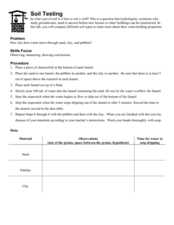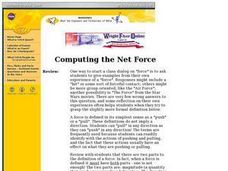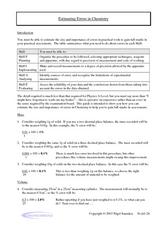Curated OER
Soil Testing
Earth science learners experiment with the water-holding properties of sand, pebbles, and clay. They apply their findings to the building of a well. This activity is engaging and tactile, and it demonstrates the importance of considering...
Music Publishers Association of the United States
I Made It. I Own It. Please Don't Steal It.
Explore the world of copyright law with a variety of activities to instill the importance of respecting creative property. Scholars watch an animated tale then take part in a grand conversation detailing the video's main idea, details,...
Kentucky School for the Deaf
Levels of Organization within an Ecosystem
From tiny organisms to entire biomes, young scientists examine the interdependent relationships tying all living and non-living things together with this collection of ecology resources.
The Science Spot
Flower Basics
Learn about plants and pollination with a activity about the parts of a flower. After labeling the anatomy of a flower using a word bank, kids explain the difference between self-pollination and cross-pollination, and unscramble the...
University of Georgia
Splat!
What does viscosity have to do with splatter? An activity shows that the viscosity of a substance is inversely proportional to the distance of its splatter. Learners conduct the experiment by collecting data, graphing, and analyzing...
Curated OER
Mitosis And Meiosis
In this science worksheet, students answer 15 questions about mitosis and meiosis. For example, "What is a major feature of prophase in mitosis?"
Curated OER
WS 1.8 Standards of Measurements
In this standards of measurements worksheet, learners watch two videos and answer six questions regarding each video. Students goal is to devise a standard of measurement after the first video.
It's About Time
The Nitrogen and Phosphorous Cycles
How do we affect the ecosystem, and what can we do to preserve it? Pupils explore chemicals that promote and inhibit plant growth, then discuss the importance of nitrogen and phosphorus to the survival of organisms and describe how...
Wilderness Classroom
Pollution
Educate scholars on pollution—air, water, and land—with a series of lessons that begin with a thorough explanation of each type. Learners then take part in three activities to reinforce the importance of reducing pollution. They...
Florida Department of Environmental Protection
Water's Journey Expedition
Step into a scientist's shoes to go online and discover the Florida Springs Expedition, and participate in two activities focusing on how humans impact the environment. The first activity asks scholars to summarize the six...
Curated OER
Cartoons for the Classroom: Vanishing Newspapers
What is happening to our newspapers? In the context of the current trends of media and the ever-declining print news industry, this handout includes two political cartoons for pupils to analyze, both created by artists working for...
Lesson Plans
Macromolecule Worksheet
Biology scholars are asked to define and explain, to complete a chart, and to fill in the blanks for seventeen macromolecule questions. Easy for pupils to read and comprehensive in content, this is a resource that you will want to use....
It's About Time
Circular Motion
Lead your class in this exciting activity to learn more about motion and its importance. Pupils learn about a centripetal and why it is required to maintain a constant speed in a circulating moving mass. They apply the equation for...
It's About Time
Plate Boundaries and Plate Interactions
How does the Earth continually repair itself? Explore the answer to this question, and others, with a unit on plate boundaries and interaction. Pupils classify the types of movement at plate boundaries and identify the...
Curated OER
Computing the Net Force
Adorable little stick figures push and pull a cart of blocks to explain the push and pull of forces. Future physicists then define force and identify it in different situations on the worksheet that follows. Concepts covered include...
Curated OER
Designing A Study
In this designing a study worksheet, students conduct a study on all types of fish that live in the Hudson River. They complete 8 various types of questions that include mostly short answer in response to their findings. Students also...
Curated OER
What is so Great about Green?
In this environment worksheet, students answer the questions, "Why is green space so important." Students explain 2 reasons using words and pictures.
Curated OER
The Purpose of Each Part of a Plant
Beginning botanists can sketch the parts of a plant in individual boxes, or better yet, they can tape or glue actual plant parts in them. Beside each box are a few sentences with selected words left out. From the word bank at the bottom...
Biology Class
Scientific Method Worksheet
Knowing the names of the steps of the scientific method is not enough; in order to really understand each of the elements, one must practice. Beginning with an engaging recap of the steps of the scientific method, learners practice the...
Curated OER
Dinnertime for Animals
Is a deer an herbivore? What about a spider? Experiment with the food chain in an interactive science experiment. After listing the herbivores from a selection of animals, third and fourth graders compare the skulls and teeth of...
Curated OER
It Can Be a Shocker!
It's important for young learners to understand how dangerous electricity can be, and how to avoid getting shocked. This worksheet enlightens them on how to avoid getting shocked, then has them answer Yes or No to eight questions...
Curated OER
Why Can’t I Have Sugar? All About Diabetes
Begin the lesson by having your class write what they know about diabetes. They learn through a skit how the body metabolizes glucose. A visual representation of the two types of diabetes is displayed, and then learners participate in...
Curated OER
Butterflies
In this science and reading comprehension worksheet, students read a 1 page detailed passage about butterflies. Students then answer 7 questions.
Curated OER
Estimating Errors in Chemistry
Estimating Errors in Chemistry is a detailed handout that illustrates the importance of calculating the percent error when working in the chemistry lab. There are no actual problems to solve, just notes and examples of calculations. Hand...























